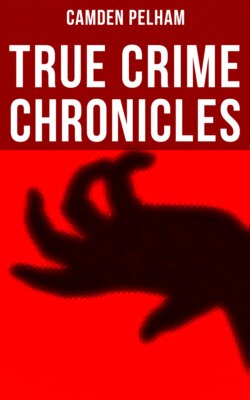Читать книгу True Crime Chronicles - Camden Pelham - Страница 105
На сайте Литреса книга снята с продажи.
JOHN HOLMES AND PETER WILLIAMS.
WHIPPED FOR STEALING DEAD BODIES.
ОглавлениеTable of Contents
THESE impious robbers were of a class now, happily, no longer in existence, thanks to the exertions of modern legislators, who have made such enactments as render the stealing dead bodies no longer profitable. The names by which such fellows were formerly known were “resurrectionists,” and “body-snatchers;” and so common—nay, so necessary was their trade for the purposes of science, that it was carried on without the smallest attempt at concealment. A monthly publication, in March 1776, says, “The remains of more than twenty dead bodies were discovered in a shed in Tottenham-court-road, supposed to have been deposited there by traders to the surgeons, of whom there is one, it is said, in the Borough, who makes an open profession of dealing in dead bodies, and is well known by the name of “The Resurrectionist.”
It is notorious that when Hunter, the famous anatomist, was in full practice, he had a surgical theatre behind his house in Windmill-street, where he gave lectures to a very numerous class of pupils, demonstrating upon stolen “subjects.” To this place such numbers of dead bodies were brought during the winter season, that the mob rose several times, and were upon the point of pulling down his house. Numberless were the instances of dead bodies being seized on their way to the surgeons; and it was known that hackney-coachmen, for an extra fare, and porters with hampers, were often employed by the resurrection-men to convey their plunder to its market.
In more recent days the establishment of Brookes, which was carried on for a purpose exactly similar to that of Hunter, has been equally well known to be supplied in the same manner. But at the same time that such a trade must have been most disgusting, and its effects most harrowing to persons, the bodies of whose friends or relations may have been carried off to be placed under the knife of the anatomist, every excuse must be made for those by whom it was supported. The advancement of science was most desirable to be obtained, and most important for the existing generation; and where the law was deficient in providing the proper means of obtaining this great end, it became requisite that measures, unlawful in themselves, it must be owned, should be adopted to secure an object, the absolute necessity of which was universally admitted.
Provisions have recently been made by Parliament, by which all body-stealing has been effectually stopped. The bodies of unclaimed paupers and suicides are now submitted to the anatomist; and under the excellent arrangements of a superintendant officer who is appointed, all hospitals and schools are well supplied, the number of bodies at his disposal being generally more than adequate to meet the demand. It should be added, that the remains are invariably buried with all that decorum and respect, which would be observed in the interment of a body under other circumstances.
But to proceed to the case now before us. Holmes, the principal offender, was grave-digger of St. George’s, Bloomsbury; Williams was his assistant; and a woman named Esther Donaldson was charged as an accomplice. They were all indicted, in December 1777, for stealing the body of Mrs. Jane Sainsbury, who departed this life on the 9th of October then last past, and whose corpse had been interred in the burying-ground of St. George’s on the Monday following. They were detected before they could secure their booty; and the widower, however unpleasant, determined to prosecute them. In order to secure their conviction, he had to undergo the painful task of viewing and identifying the remains of his wife.
The grave-digger and his deputy were convicted on the fullest evidence; and the acquittal of the woman was much regretted, as no doubt remained of her equal guilt. She was therefore released; but Holmes and Williams were sentenced to six months’ imprisonment, and to be whipped twice on their bare backs from the end of Kingsgate-street, Holborn, to Dyot-street, St. Giles’s, a distance of half a mile. The sentence was duly carried out, amidst crowds of well-satisfied and approving spectators.
